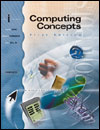Total quality management and business process reengineering are both "best" business practices that focus on improving processes. However, there are some real differences between the
two. Total quality management
(
TQM
) is meeting customer expectations through continuous
improvement and organization-wide quality ownership. Important
considerations here include: - Meeting customer expectations
-- if you don't do this, you will fail.
- Continuous improvement
-- constantly monitoring the quality of processes and
improving them as customer expectations change.
- Transaction process and customer-integrated systems help
gather process information.
- Statistical process control (SPC) tools such as control
charts, histograms, fishbone diagrams, pareto charts, and
scatter diagrams are then used to evaluate the process
information and determine improvements.
- Organization-wide quality ownership
-- TQM requires a commitment from every individual in an
organization. So, employees must have access to information
(the concept of shared information) and must have the
technology tools to access and use that information (the
concept of decentralized computing).
Business process reengineering
(
BPR
) is the reinventing of processes within a business. - So, while TQM focuses on improving processes, BPR focuses
on completely destroying old processes and inventing
radically new ones that result in dramatic increased
efficiencies.
- BPR is almost always technology-enabled and can very
seldom occur without the use of technology.
If you're interested in learning more about total
quality management (TQM) and business process reengineering
(BPR), we suggest the following resources. BUSINESS PROCESS REENGINEERING - Reengineering the Corporation: A Manifesto for Business
Revolution
, by Hammer and Champy
- Beyond Reengineering: How the Processed-Centered
Organization Is Changing Our Work and Our lives
, by Hammer
- The Reengineering Handbook: A Step-by-Step Guide to
Business Transformation
, by Manganelli and Klein
- Business Process Improvement
, by Harrington
- Brint.com
-- numerous BPR Web resources
TOTAL QUALITY MANAGEMENT - Productivity and Quality Improvement
, by Hradesky
- Quality is Free
, by Crosby
- Managing the Total Quality Transformation
, by Berry
- The Kaizen Blitz: Accelerating Breakthroughs in
Productivity and Performance
, by Laraia
- TQMPapers.com
-- examples of TQM term papers and research; great for
college students
|




 2002 McGraw-Hill Higher Education
2002 McGraw-Hill Higher Education